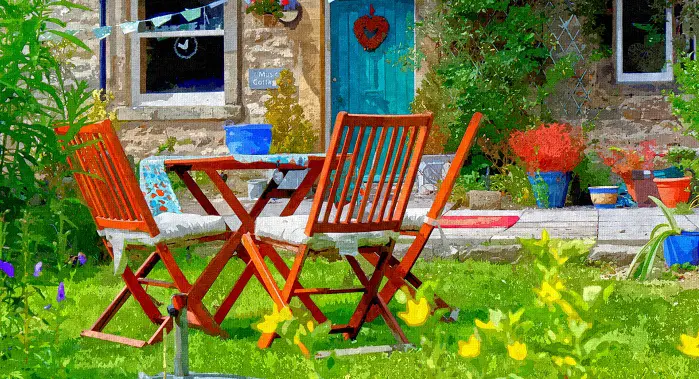There is a common tendency to refer to cottage gardens as “English cottage gardens.”
This article will briefly examine the differences between English gardens, popular for their more controlled appearance, and cottage gardens, popular for their more natural appearance.
Cottage gardens originated in medieval Europe. Cottage gardens traditionally featured fragrant perennials and medicinal and edible plants.
These perennials were deliberately chosen for their pleasant fragrances. This was to make up for the absence of bathing facilities in each house.
The cottage garden has changed little over the years, evolving into a combination of annuals and perennials typical of English gardens.
This is with greenery, herbs and possibly even a fruit tree. A border of shrubs or a short wall can enclose all these plants and provide structure for an otherwise wild garden.
What is an English garden?

The concept of the English garden was first seen during the Roman era, which began in the 1800s.
This philosophical shift encouraged people to rekindle their connections to the natural world. In addition, they share their whole range of emotions, inner thoughts, and life experiences.
English aristocrats reacted to this social upheaval by incorporating classical architectural features like masonry walls, sculptured walks, geometric patterns, and opulent statues into their outdoor spaces.
Gardeners for the English aristocracy used sheared English yews or brick walls to demarcate different areas.
Beds of clipped annual and perennial flowers, flowering herbs, and groundcovers crops of similar height and texture for added fragrance and food would come to be known as an “English garden.”
Making your own English garden
Since there are so many examples, it’s easy to see why a modern gardener might find it hard to make a real English garden at home. Even though a garden like this may look like it grew on its own, it was actually carefully planned.
Think about the feelings this garden might inspire, feelings that may have their origins in the English garden’s emphasis on individuality, natural beauty, and the balance of colors, space and light. Some suggestions for enriching an English garden’s variety and depth include:
- Add more plants
The typical English garden makes the most of its limited space. Choose flowering plants of varying textures, shapes, and sizes and relax your regulations on plant spacing. They will cluster and overflow your flower bed and pots.
- Use water element
Many professionals agree that a water feature is crucial to the success of an English garden. Any kind of water feature makes it easier to feel calm and take time to think.
Create a pond (either natural or manmade) in the center of a larger area and landscape around it with shrubs, tress and rocks. Put ceramic or sculpture pieces all around the fountain.
- Use materials found in your home
Brick or stone walls, maybe in keeping with the style of your neighboring home, are a lovely accent to an English garden.
- Add smaller objects
Putting a gazing ball in front of your evergreen hedge or a brightly colored watering among your flowers can add some fun to your garden.
- Add wooden elements
The majority of outdoor structures in English gardens feature wood. Plant some bougainvillea, wisteria, or jasmine on a closed pergola.
Don’t forget to incorporate a comfortable seating area within your garden. Furniture constructed of bent willow, wrought iron, wood, or wicker all does the trick.
- Swap out open areas for enclosed ones
Small hills and lawns are examples of open regions, while dense forests are examples of closed areas where tree branches have grown together.
Add some little stone caves or other architectural buildings in the baroque, modern, or neoclassical styles for a nice contrast between open and closed spaces.
What is a cottage garden?

The rustic beauty of a cottage garden is undeniable. Fruit trees, vegetables, flowers, and herbs overflow densely planted garden beds.
Cottage gardens thrive with a wide variety of plants, including rosemary, poppies, calamondin citrus, lavender hedges, berries, stone fruit and even vegetables.
Cottage edibles go well with obelisks, timber garden posts, wooden raised beds, homemade wicking beds and traditional bench seats or rose arbors. You can finish the look with a brush or picket fence.
This is a good way to garden for people who like the beauty and smell of flowers and the bounty of a homegrown harvest. Beautiful chaos is their ideal environment. A barn, bungalow, or historic villa-style building would look lovely in a potager garden.
What are the rules of cottage garden style?
None exist. Indeed, that is the whole point. Planting in groups of 3 or 5, drifts, or even considering complementary colors is optional.
If a plant is given to you, you will find a way to squeeze it in. It may not appreciate being crammed in, but such is the nature of cottage gardens. Those that are toughest will also be the most attractive.
The plants in a cottage garden require little maintenance. These plants can propagate themselves with little effort. They will not care if you’re in the correct area.
Conclusion
Traditional English gardens, cottage gardens and moon garden mostly differ in how much they cost, how big they are, and how skilled the people who design them are.
Both English gardens and cottage gardens are places to relax and think. This is because they use flowers such as hibiscus plant and Rose of Sharon which have color drifts to create a natural, organic look.
